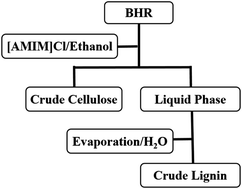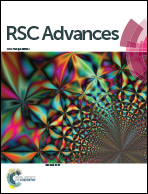Cellulose enzymatic saccharification and preparation of 5-hydroxymethylfurfural based on bamboo hydrolysis residue separation in ionic liquids†
Abstract
Ionic liquid/ethanol was used in bamboo hydrolysis residue (BHR) to separate lignin and cellulose. The optimal dissolution conditions were as follows: 160 °C, 150 min, 1 : 1 of volume ratio of [AMIM]Cl to ethanol, 1 : 10 of mass ratio of solid to liquid, when the dissolution rate was 41.7%, the purity of crude lignin was 86.7%, while that of cellulose product was 92.0%. Additionally the recycling effect of [AMIM]Cl/ethanol was ideal. The crystal structure of cellulose had not been destroyed; its crystallinity increased. Cellulose enzymatic saccharification was investigated, and the optimum process conditions were as follows: 50 °C, 48 h, 2 g L−1 of cellulase concentration, pH = 4.5, when the saccharification yield reached 83.7%. The cellulose crystal structure was destroyed and its degree of crystallinity was decreased after saccharification. Then the monosaccharide was used to convert to 5-hydroxymethylfurfural (5-HMF) under Brønsted acids or Lewis acids catalysis in [AMIM]OAc. It was found that the catalytic effect of Lewis acids was much better than that of Brønsted acids investigated, especially CrCl3. Choosing CrCl3 as catalyst, the optimum process conditions were as follows: 1 : 10 of mass ratio of solid to liquid, 10 mol% (based on monosaccharide) CrCl3, 160 °C, 3 h, when the 5-HMF yield reached 56.8%.



 Please wait while we load your content...
Please wait while we load your content...